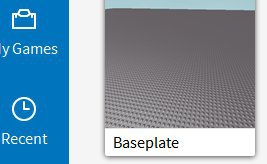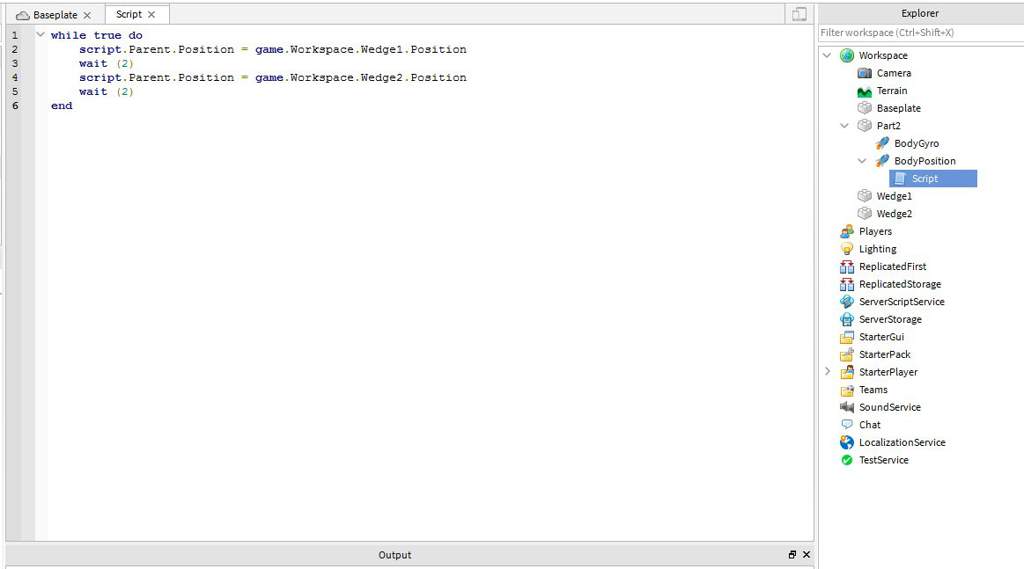lua скрипты для роблокс
Scripts
For use in Lua executors
Can’t find what you want? Try searching the forum at this link. Post there for a chance at your script being here!
Dex Explorer V2
A powerful game explorer GUI. Shows every instance of the game and all their properties. Useful for developers.
Why walk when you can fly?
Aimbot
Snaps aim to player heads. Featuring wall detection, team check, and mouse movement bypass.
Gravity Switch
Press «e» to toggle the game’s gravity
Focus Anti-AFK
Even when you switch to another window, you will appear to be active.
Demonfall Trainer
A Demonfall trainer featuring a mob ESP, auto breath, god mode, anti-debuffs, and trinket farm.
Phantom Forces Hitbox Expander
Makes enemies easier to hit by enlarging their hitbox.
Slowly, but surely automatically farms in the game Timber.
Apoc2 Map Radar
Puts all other players onto your mini-map in Apoc Rising 2.
World Zero Kill Aura
Adds a kill aura for the game, World // Zero.
Critical Strike GUI
Displays a cheat trainer to use for the game, Critical Strike.
PF Easy Fly
Enables you to fly through the game, Phantom Forces.
RoCitizens Infinite Money
Drown in cash while playing RoCitizens.
Click Teleport
Left ctrl + click on any spot on the game and you will immediately teleport to it!
Human Flashlight
Turns your character into a private flashlight.
Remove Legs
Removes the legs from your player’s character.
Float Character
Makes your player’s character float in the air.
High Hips
Walk like normal, but a little «taller».
BTools
Gives your player the old system of building tools.
Night Time Toggle
Changes the time of day so that it is night.
Limp Character
Messes with your characters joints so it walks with a limp.
Blockhead
Turns your character’s head into a plain block.
Highlight Player
Places a selection box around the selected player.
Remove Arms
Removes the arms from your player’s character.
Invisible Character
Makes your character’s baseparts fully transparent.
Magnetize To Player
Makes your character magnetically attracted to another player.
Teleport To Player
Teleports your player’s character to the selected player’s character
Unlock Workspace Baseparts
Unlocks all bricks in the game so you can use btools on them.
Universal ESP and Aimbot.txt
Introduces an ESP and aimbot for all games.
WRD ESP
Draws boxes around other players. As used in JJSploit.
Roblox Lua Style Guide¶
This style guide aims to unify as much Lua code at Roblox as possible under the same style and conventions.
This guide is designed after Google’s C++ Style Guide. Although Lua is a significantly different language, the guide’s principles still hold.
Guiding Principles¶
File Structure¶
Files should consist of these things (if present) in order:
Requires¶
Use relative paths when importing modules from the same package.
Use absolute paths when importing modules from a different package.
Metatables¶
Metatables are an incredibly powerful Lua feature that can be used to overload operators, implement prototypical inheritance, and tinker with limited object lifecycle.
At Roblox, we limit use of metatables to a couple cases:
Prototype-based classes¶
The most popular pattern for classes in Lua is sometimes referred to as the One True Pattern. It defines class members, instance members, and metamethods in the same table and highlights Lua’s strengths well.
First up, we create a regular, empty table:
Next, we assign the __index member on the class back to itself. This is a handy trick that lets us use the class’s table as the metatable for instances as well.
When we construct an instance, we’ll tell Lua to use our __index value to find values that are missing in our instances. It’s sort of like prototype in JavaScript, if you’re familiar.
We can also define methods that operate on instances. These are just methods that expect their first argument to be an instance. By convention, we define them using a colon ( : ):
At this point, our class is ready to use!
We can construct instances and start tinkering with it:
Further additions you can make to your class as needed:
Add a method to check type given an instance, like:
Guarding against typos¶
Indexing into a table in Lua gives you nil if the key isn’t present, which can cause errors that are difficult to trace!
Our other major use case for metatables is to prevent certain forms of this problem. For types that act like enums, we can carefully apply an __index metamethod that throws:
Since __index is only called when a key is missing in the table, MyEnum.A and MyEnum.B will still give you back the expected values, but MyEnum.FROB will throw, hopefully helping engineers track down bugs more easily.
General Punctuation¶
General Whitespace¶
No vertical alignment!
Use a single empty line to express groups when useful. Do not start blocks with a blank line. Excess empty lines harm whole-file readability.
Use one statement per line. Put function bodies on new lines.
This is especially true for functions that return multiple values. Compare these two statements:
It’s much easier to spot the mistake (and much harder to make in the first place) if the function isn’t on one line.
This is also true for if blocks, even if their body is just a return statement.
Most of the time this pattern is used, it’s because we’re performing validation of an input or condition. It’s much easier to add logging, or expand the conditional, when the statement is broken across multiple lines. It will also diff better in code review.
Put a space before and after operators, except when clarifying precedence.
Put a space after each commas in tables and function calls.
When creating blocks, inline any opening syntax elements.
Avoid putting curly braces for tables on their own line. Doing so harms readability, since it forces the reader to move to another line in an awkward spot in the statement.
Newlines in Long Expressions¶
First, try and break up the expression so that no one part is long enough to need newlines. This isn’t always the right answer, as keeping an expression together is sometimes more readable than trying to parse how several small expressions relate, but it’s worth pausing to consider which case you’re in.
It is often worth breaking up tables and arrays with more than two or three keys, or with nested sub-tables, even if it doesn’t exceed the line length limit. Shorter, simpler tables can stay on one line though.
Prefer adding the extra trailing comma to the elements within a multiline table or array. This makes it easier to add new items or rearrange existing items.
Break dictionary-like tables with more than a couple keys onto multiple lines.
Break list-like tables onto multiple lines however it makes sense.
For long argument lists or longer, nested tables, prefer to expand all the subtables. This makes for the cleanest diffs as further changes are made.
In some situations where we only ever expect table literals, the following is acceptable, though there’s a chance automated tooling could change this later. In particular, this comes up a lot in Roact code ( doSomething being Roact.createElement ).
However, this case is less acceptable if there are any non-tables added to the mix. In this case, you should use the style above.
For long expressions try and add newlines between logical subunits. If you’re adding up lots of terms, place each term on its own line. If you have parenthesized subexpressions, put each subexpression on a newline.
For long conditions in if statements, put the condition in its own indented section and place the then on its own line to separate the condition from the body of the if block. Break up the condition as any other long expression.
Blocks¶
Use do blocks if limiting the scope of a variable is useful.
Literals¶
Use double quotes when declaring string literals.
Tables¶
Add trailing commas in multi-line tables.
Functions¶
Always use parentheses when calling a function. Lua allows you to skip them in many cases, but the results are typically much harder to parse.
Declare named functions using function-prefix syntax. Non-member functions should always be local.
Comments¶
Use single line comments for inline notes:
Use block comments for documenting items:
Comments should focus on why code is written a certain way instead of what the code is doing.
No section comments.
Some examples of ways of breaking up files:
If you can’t break the file up, and still feel like you need section headings, consider these alternatives.
If you want to put a section header on a group of functions, put that information in a block comment attached to the first function in that section. You should still make sure the comment is about the function its attached to, but it can also include information about the section as a whole. Try and write the comment in a way that makes it clear what’s included in the section.
The same can be done for a group of variables in some cases. All the same caveats apply though, and you have to consider whether one block comment or a normal comment on each variable (or even using just whitespace to separate groups) would be more readable.
Naming¶
Yielding¶
Pros:
Cons:
Unintended yielding can cause hard-to-track data races. Simple code involving callbacks can cause confusing bugs if the input callback yields.
Error Handling¶
Do not throw errors except when validating correct usage of a function.
Pros:
Cons:
Exceptions:
Роблокс Lua Learning (0)
Приветствую на моём посте
Сегодня я расскажу и покажу, что такое язык Lua и как он работает
Научиться этому языку довольно просто, сегодня я расскажу про пару функций этого языка.
Для начала нам нужно открыть Roblox Studio.
После того, как вы открыли Studio вам нужно выбрать New, после чего выбрать Baseplate
Попробуем сделать что-нибудь простое, например платформу, которая будет летать с 1 края на другой
Для начала делаем детали, которые нам нужны
В детали, которая будет платформой создаём BodyPosition, после чего создаём там скрипт
На языке Lua, как я уже говорил ранее, всё просто.
Попробуем продумать, что именно нам нужно.
Нужно, чтобы позиция платформы поменялась на позицию 1 края, после, например через 2 секунды на позицию 2 края, после подождать 2 секунды и повторить опять.
Теперь я переведу это на язык Lua
Скрипт.Родитель.Позиция переделать на Игра.Угол1.Позиция
Скрипт.Родитель.Позиция переделать на Игра.Угол2.Позиция
Это и есть наш скрипт
Как вы наверное поняли, предложения соответствуют скрипту, поэтому вам лишь нужно придумать, как сказать то, что вы хотите сделать, после чего написать скрипт.
(Это был лишь пробный выпуск Lua Learning, в дальнейшем я планирую сделать 2 часть, где я подробно объясню, что значат какие-либо команды)
What is ROBLOX Lua scripting? [closed]
Want to improve this question? Update the question so it focuses on one problem only by editing this post.
I really dont understand what it really even is. Is it just normal scripting or something else?
7 Answers 7
Lua is a fairly well known and often embedded scripting language.
However, if you’re after some basic «getting starting» information on Roblox scripting, check out the Roblox Wiki. (The tutorial’s section would probably be of specific interest.)
Lua is a well known scripting and programming language that is lightweight and easy to learn. Many games have embedded it, including Garry’s Mod (GMod) and World of Warcraft.
ROBLOX uses Lua to actually create games. Most of the features you see in ROBLOX (like the GUI and building tools) are actually coded in Lua.
I’d recommend seeing games by Anaminus, VolcanoINC and Telamon to see what you could do with Lua.
Lua is a scripting language somewhat similar to Java. Infact, I recall there being a Javalua blend as a scripting language in itself. Lua is probably the easiest scripting language to learn and work with. Its functions are fired by changes specified such as script.Parent.Value.Changed:connect(functionnamehere)
Parents are what the script or item specified is in. Variables work like this:
If a ROBLOX Solo Game is the source and v’s script.Parent’s name (script.Parent.Name) is ScriptFireValue then v is equal to d.
The language also includes loops that are recognizable like
‘for’ is a limited loop where it only loops for a certain amount of times. exe.
I think a few more.
Here’s an example script I’m writing off the top of my head. The source I’m going off of is ROBLOX’s Build/Edit mode in-game.
That script if not obvious identified the player who clicked. (clicker). Btw the argument ‘clicker’ would be identified the cause of the function to be fired. So the cause is because a button was ‘Clicked’. So ‘clicker’ retrieves the person who initiated that. Therefore identifying if the player is a certain person which would allow the process to continue. So if the player’s name is coolboy10000 then it will gather all the players and kill them each.
To put a security on that button to where if the player is not coolboy10000 then the player will be killed you could do this:
If there are multiple people to allow to do this function you could do:
Or if there is a specific person who should have a separate punishment:
Yeah that’s just the basics :/ There are tutorials out there. Mostly on ROBLOX free models. I say you should study some free scripts and learn how they work and stuff. This is just the basics. There is a tutorial on ROBLOX. Just search in Free Models scripting tutorials. Some dude wrote in scripts how to script. It’s pretty long to read but that’s how I learned.
Lua Globals
The following is a list of functions and variables that are native to Lua. These functions can be used in a standard installation of Lua 5.1.4, though there are some differences in how some of these work on Roblox.
Functions
Throws an error if the provided value is false or nil. If the assertion passes, it returns all values passed to it.
Performs an operation on the Lua garbage collector based on the specified option.
Roblox’s Lua sandbox only allows the “count” option to be used, so none of the other standard options are available.
The “count” option returns the total memory in use by Lua (in kilobytes).
Terminates the last protected function called and outputs message as an error message. If the function containing the error is not called in a protected function (pcall), then the script which called the function will terminate. The error function itself never returns and acts like a script error.
The level argument specifies how to get the error position. With level 1 (the default), the error position is where the error function was called. Level 2 points the error to where the function that called error was called; and so on. Passing a level 0 avoids the addition of error position information to the message.
Returns the current environment in use by the caller.
Usage
Getting the Current Environment
Getting the Environment of a Function
Getting the Environment Based on Stack
Returns the metatable of the given table t if it has one, otherwise returns nil. If t does have a metatable, and the __metatable metamethod is set, it returns that value instead.
Returns three values: an iterator function, the table t and the number 0. Each time the iterator function is called, it returns the next numerical index-value pair in the table. When used in a generic for-loop, the return values can be used to iterate over each numerical index in the table:
Loads Lua code from a string, and returns it as a function.
Unlike standard Lua 5.1, Roblox’s Lua cannot load the binary version of Lua using loadstring.
The behavior of next is undefined if, during the traversal, you assign any value to a non-existent field in the table. You may, however, modify existing fields. In particular, you may clear existing fields.
Returns an iterator function, the passed table t and nil, so that the construction will iterate over all key/value pairs of that table when used in a generic for-loop:
Calls the function func with the given arguments in protected mode. This means that any error inside func is not propagated; instead, pcall catches the error and returns a status code. Its first result is the status code (a boolean), which is true if the call succeeds without errors. In such case, pcall also returns all results from the call, after this first result. In case of any error, pcall returns false plus the error message.
Checks whether v1 is equal to v2, without invoking any metamethod.
Gets the real value of table[index], without invoking any metamethod.
Sets the real value of table[index] to a given value, without invoking any metamethod.
Returns all arguments after argument number index. If negative, it will return from the end of the argument list.
Returns the total number of arguments that were passed after the cmd argument, which must be «#» to use select in this fashion.
Sets the environment to be used by the given function. f can be a function or a number that specifies the function at that stack level: Level 1 is the function calling setfenv. setfenv returns the given function.
As a special case, when f is 0 setfenv changes the environment of the running thread. In this case, setfenv returns no values.
Attempts to convert the arg into a number with a specified base to interpret the value in. If it cannot be converted, this function returns nil.
The base may be any integer between 2 and 36, inclusive. In bases above 10, the letter ‘A’ (in either upper or lower case) represents 10, ‘B’ represents 11, and so forth, with ‘Z’ representing 35. In base 10 (the default), the number may have a decimal part, as well as an optional exponent part. In other bases, only unsigned integers are accepted.
If a string begins with “0x” and a base is not provided, the 0x is trimmed and the base is assumed to be 16, or hexadecimal.
Receives an argument of any type and converts it to a string in a reasonable format. For complete control of how numbers are converted, use string.format. If the metatable of e has a __tostring metamethod, then it will be called with e as the only argument and will return the result.
Returns the type of its only argument, coded as a string. The possible results of this function are “nil” (a string, not the value nil), “number”, “string”, “boolean”, “table”, “function”, “thread”, and “userdata”.
Returns the elements from the given table. By default, i is 1 and j is the length of list, as defined by the length operator.
This function is similar to pcall, except that you can set a new error handler.
xpcall calls function f in protected mode, using err as the error handler, and passes a list of arguments. Any error inside f is not propagated; instead, xpcall catches the error, calls the err function with the original error object, and returns a status code. Its first result is the status code (a boolean), which is true if the call succeeds without errors. In this case, xpcall also returns all results from the call, after this first result. In case of any error, xpcall returns false plus the result from err.
Variables
A table that is shared between all scripts of the same context level.
A global variable (not a function) that holds a string containing the current interpreter version.
How this site use cookies
This Platform uses cookies to offer you a better experience, to personalize content, to provide social media features and to analyse the traffic on our site. For further information, including information on how to prevent or manage the use of cookies on this Platform, please refer to our Privacy and Cookie Policy.





